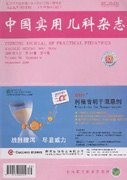Bronchiolitis is a common lower respiratory tract infection in infants and young children, mostly caused by respiratory syncytial virus. At present, the treatment mainly includes oxygen therapy, control of wheezing, maintenance of internal environment stability and so on. Most cases of bronchiolitis still lack specific antimicrobial agents. To explore a new treatment method for bronchiolitis is helpful to improve the symptoms, shorten hospitalization days,and improve the prognosis of children with moderate to severe bronchiolitis, especially those younger than 6 months with high risk factors.

